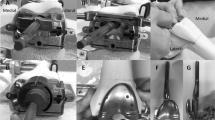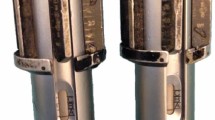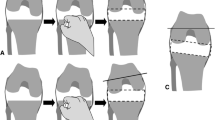Abstract
Purpose
Sagittal gap balancing (relation between flexion and extension gaps) with placement of trial femoral components and reduction of the patella in total knee arthroplasty (TKA) is important, but it is not easy. The purpose of this study was to investigate whether (1) the flexion and extension gaps were equal when a previously suggested three-dimensional planning for a single-radius femoral component (its sagittal centre is matched with flexion-extension axis of knee movement) is executed with patient-specific instrumentation (PSI) and whether (2) PSI was done with good accuracy, which did not affect the first purpose.
Methods
Posterior cruciate ligament sacrificed (PS) TKA was performed on 12 joints. Using the patients’ pre-operative computed tomography (CT) images, PSI was manufactured to fit on the bony surface of the knee joint and to simultaneously transfer pre-operative planning to the operating room. After osteotomy with PSI, gap measurements were calculated with the knee in flexion and extension. Angle deviations of both components were investigated with postoperative CT images.
Results
The flexion gap (mean, 19.1 mm) was larger than the extension gap (mean, 12.3 mm) in all cases. Angle differences between pre- and postoperative alignments were within 3° in all cases.
Conclusions
Although PSI executed the pre-operative planning with good accuracy, the flexion gap is always larger than the extension gap. This finding suggests that surgeons may not aim for equal gaps of flexion and extension in PS-TKA.


Similar content being viewed by others
References
Winemaker MJ (2002) Perfect balance in total knee arthroplasty: the elusive compromise. J Arthroplasty 17:2–10
Insall J, Ranawat CS, Scott WN, Walker P (1976) Total condylar knee replacement: preliminary report. Clin Orthop Relat Res 120:149–154
Griffin FM, Insall JN, Scuderi GR (2000) Accuracy of soft tissue balancing in total knee arthroplasty. J Arthroplasty 15(8):970–973
Tanzer M, Smith K, Burnett S (2002) Posterior-stabilized versus cruciate-retaining total knee arthroplasty. Balancing the gap. J Arthroplasty 17:813–819
Incavo SJ, Coughlin KM, Beynnon BD (2004) Femoral component sizing in total knee arthroplasty: size matched resection versus flexion space balancing. J Arthroplasty 19(4):493–497
Matsumoto T, Muratsu H, Tsumura N, Mizuno K, Kurosaka M, Kuroda R (2009) Soft tissue balance measurement in posterior-stabilized total knee arthroplasty with a navigation system. J Arthroplasty 24(3):358–364
Muratsu H, Matsumoto T, Kubo S, Maruo A, Miya H, Kurosaka M et al (2010) Femoral component placement changes soft tissue balance in posterior-stabilized total knee arthroplasty. Clin Biomech (Bristol, Avon) 25(9):926–930
Hananouchi T, Yamamoto K, Ando W, Fudo K, Ohzono K (2012) The intraoperative gap difference (flexion gap minus extension gap) is altered by insertion of the trial femoral component. Knee 19(5):601–605
Lombardi AVJ, Berend KR, Adams JB (2008) Patient-specific approach in total knee arthroplasty. Orthopedics 31:927–930
Krishnan SP, Dawood A, Richards R, Henckel J, Hart AJ (2012) A review of rapid prototyped surgical guides for patient-specific total knee replacement. J Bone Joint Surg (Br) 94:1457–1461
Nam D, McArthur BA, Cross MB, Pearle AD, Mayman DJ, Haas SB (2012) Patient-specific instrumentation in total knee arthroplasty: a review. J Knee Surg 25:213–219
Thienpont E, Bellemans J, Delport H, Van Overschelde P, Stuyts B, Brabants K et al (2013) Patient-specific instruments: industry’s innovation with a surgeon’s interest. Knee Surg Sports Traumatol Arthrosc 21(10):2227–2233
Hananouchi T, Nakamura N, Kakimoto A, Yohsikawa H, Sugano N (2008) CT-based planning of a single-radius femoral component in total knee arthroplasty using the ROBODOC system. Comput Aided Surg 13(1):23–29
Stoddard JE, Deehan DJ, Bull AM, McCaskie AW, Amis AA (2013) The kinematics and stability of single-radius versus multi-radius femoral components related to mid-range instability after TKA. J Orthop Res 31(1):53–58
Berger RA, Rubash HE, Seel MJ, Thompson WH, Crossett LS (1993) Determining the rotational alignment of the femoral component in total knee arthroplasty using the epicondylar axis. Clin Orthop Relat Res 286:40–47
Uehara K, Kadoya Y, Kobayashi A, Ohashi H, Yamano Y (2002) Bone anatomy and rotational alignment in total knee arthroplasty. Clin Orthop Relat Res 402:196–201
Akagi M, Yamashita E, Nakagawa T, Asano T, Nakamura T (2001) Relationship between frontal knee alignment and reference axes in the distal femur. Clin Orthop Relat Res 388:147–156
Chinzei N, Ishida K, Tsumura N, Matsumoto T, Kitagawa A, Iguchi T et al (2014) Satisfactory results at 8 years mean follow-up after ADVANCE® medial-pivot total knee arthroplasty. Knee 21(2):387–390
Barnes CL, Sharma A, Blaha JD, Nambu SN, Carroll ME (2011) Kneeling is safe for patients implanted with medial-pivot total knee arthroplasty designs. J Arthroplasty 26(4):549–554
Fan CY, Hsieh JT, Hsieh MS, Shih YC, Lee CH (2010) Primitive results after medial-pivot knee arthroplasties: a minimum 5-year follow-up study. J Arthroplasty 25(3):492–496
Matsumoto T, Kuroda R, Kubo S, Muratsu H, Mizuno K, Kurosaka M (2009) The intra-operative joint gap in cruciate-retaining compared with posterior-stabilised total knee replacement. J Bone Joint Surg (Br) 91(4):475–480
Matsumoto T, Muratsu H, Kubo S, Matsushita T, Kurosaka M, Kuroda R (2011) Soft tissue tension in cruciate-retaining and posterior-stabilized total knee arthroplasty. J Arthroplasty 26(5):788–795
Matsumoto T, Muratsu H, Kubo S, Matsushita T, Kurosaka M, Kuroda R (2012) Intraoperative soft tissue balance reflects minimum 5-year midterm outcomes in cruciate-retaining and posterior-stabilized total knee arthroplasty. J Arthroplasty 27(9):1723–1730
Matsumoto T, Kubo S, Muratsu H, Matsushita T, Ishida K, Kawakami Y et al (2013) Different pattern in gap balancing between the cruciate-retaining and posterior-stabilized total knee arthroplasty. Knee Surg Sports Traumatol Arthrosc 21(10):2338–2345
Matsumoto T, Muratsu H, Kawakami Y, Takayama K, Ishida K, Matsushita T et al (2014) Soft-tissue balancing in total knee arthroplasty: cruciate-retaining versus posterior-stabilised, and measured-resection versus gap technique. Int Orthop 38(3):531–537
Oka S, Matsumoto T, Muratsu H, Kubo S, Matsushita T, Ishida K et al (2014) The influence of the tibial slope on intra-operative soft tissue balance in cruciate-retaining and posterior-stabilized total knee arthroplasty. Knee Surg Sports Traumatol Arthrosc 22(8):1812–1818
Nishizawa Y, Matsumoto T, Kubo S, Muratsu H, Matsushita T, Oka S et al (2013) The influence of patella height on soft tissue balance in cruciate-retaining and posterior-stabilised total knee arthroplasty. Int Orthop 37(3):421–425
Mihalko WM, Krackow KA (1999) Posterior cruciate ligament effects on the flexion space in total knee arthroplasty. Clin Orthop Relat Res (360):243–250
Kadoya Y , Kobayashi A, Komatsu T, Nakagawa S, Yamano Y (2001) Effects of posterior cruciate ligament resection on the tibiofemoral joint gap. Clin Orthop Relat Res (391):210–217
Park SJ, Seon JK, Park JK, Song EK (2009) Effect of PCL on flexion-extension gaps and femoral component decision in TKA. Orthopedics 32(10 Suppl):22–25
Chaiyakit P, Meknavin S, Hongku N (2009) Effects of posterior cruciate ligament resection in total knee arthroplasty using computer assisted surgery. J Med Assoc Thai 92 Suppl 6:S80–84
Matthews J, Chong A, McQueen D, O’Guinn J, Wooley P (2014) Flexion-extension gap in cruciate-retaining versus posterior-stabilized total knee arthroplasty: a cadaveric study. J Orthop Res 32(5):627–632
Schnurr C, Eysel P, König DP (2012) Is the effect of a posterior cruciate ligament resection in total knee arthroplasty predictable? Int Orthop 36(1):83–88
Ng VY, Declaire JH, Berend KR, Gulick BC, Lombardi AV Jr (2012) Improved accuracy of alignment with patient-specific positioning guides compared with manual instrumentation in TKA. Clin Orthop Relat Res 470(1):99–107
Nunley RM, Ellison BS, Zhu J, Ruh EL, Howell SM, Barrack RL (2012) Do patient-specific instrumentations improve coronal alignment in total knee arthroplasty? Clin Orthop Relat 470(3):895–902
Victor J, Dujardin J, Vandenneucker H, Arnout N, Bellemans J (2014) Patient-specific instrumentations do not improve accuracy in total knee arthroplasty: a prospective randomized controlled trial. Clin Orthop Relat Res 472(1):263–271
Delport H, Chandrashekar P (2012) The use of patient-specific intra-operative guides for total knee arthroplasty (TKA). Arch Clin Exp Surg 1(4):206–212
Acknowledgments
The author would like to thank Dr. Kengo Yamamoto and Dr. Wataru Ando for data collection.
Author information
Authors and Affiliations
Corresponding author
Additional information
This work was performed at the Kansai Rosai Hospital.
Rights and permissions
About this article
Cite this article
Hananouchi, T. Sagittal gap balancing with the concept of a single radius femoral component in posterior cruciate sacrificing total knee arthroplasty with patient-specific instrumentation. International Orthopaedics (SICOT) 39, 659–665 (2015). https://doi.org/10.1007/s00264-014-2536-2
Received:
Accepted:
Published:
Issue Date:
DOI: https://doi.org/10.1007/s00264-014-2536-2




